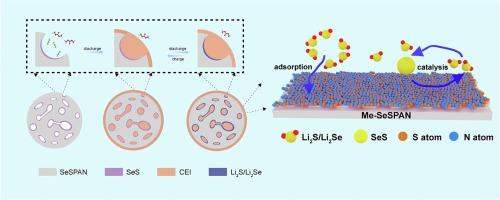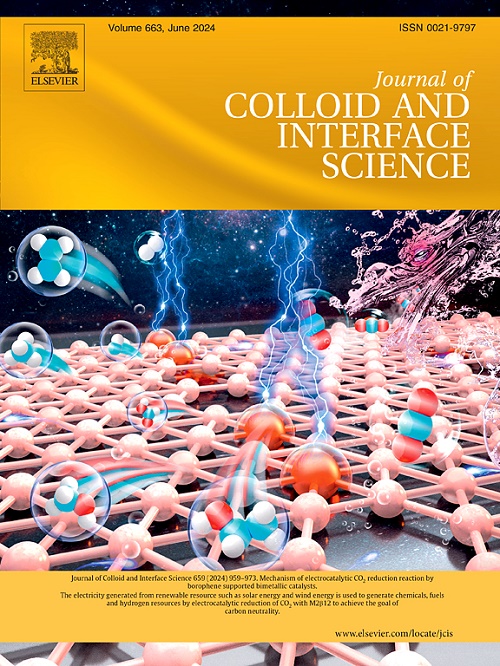利用硫化聚丙烯腈阴极中的空间致密介孔纳米反应器提高锂硫电池的性能
IF 9.4
1区 化学
Q1 CHEMISTRY, PHYSICAL
引用次数: 0
摘要
硫化聚丙烯腈(SPAN)被认为是一种很有前途的锂硫电池(Li-SB)正极材料,它能有效缓解多硫化物溶解产生的穿梭效应。然而,传统的 SPAN 阴极的硫含量通常低于 40 wt%。虽然通过固体电解质界面将硫封装在孔隙中解决了硫负荷低的问题,但固固反应的次优动力学阻碍了孔隙中硫的有效利用。在这项工作中,通过电纺丝和熔盐辅助热解 ZIF-8 成功合成了 Me-SeSPAN/SeS 纤维膜,从而形成了空间受限的互连介孔纳米反应器。这些纳米反应器起着补充存储空间的作用,可以装载和限制内部活性材料簇的大小。纤维膜有利于 Li+ 通过孔隙运动,并通过空间约束效应促进放电产物 Li2S 在孔壁上的吸附。根据密度泛函理论(DFT)计算,这一过程保证了电子和 Li+ 对活性材料的供应,从而在氧化还原反应期间实现了连续的电子转移。优化后的 Me-SeSPAN/SeS 电极的硫和硒含量为 70 wt%,在纽扣电池和袋式电池中均表现出卓越的循环稳定性。这项研究为提高封装在 SPAN 阴极中的活性材料的动力学性能提供了一种有效的策略。本文章由计算机程序翻译,如有差异,请以英文原文为准。

Enhancing the performance of a lithium-sulfur battery with spatially confined mesoporous nanoreactors in sulfurized polyacrylonitrile cathodes
Sulfurized polyacrylonitrile (SPAN), which is recognized as a promising cathode material for lithium-sulfur batteries (Li-SBs), effectively mitigates the shuttle effect resulting from polysulfide dissolution. However, conventional SPAN cathodes typically exhibit sulfur loadings below 40 wt%. While encapsulation of sulfur within pores via a solid electrolyte interface addresses the low sulfur loading issue, the suboptimal kinetics of the solid–solid reactions hinder effective utilization of sulfur within the pores. In this work, Me-SeSPAN/SeS fibrous membranes were successfully synthesized through electrospinning and molten salt-assisted pyrolysis of ZIF-8, which resulted in the formation of spatially confined interconnected mesoporous nanoreactors. These nanoreactors function as supplementary storage spaces, loading and constraining the size of internal active material clusters. The fibrous membranes facilitate Li+ movement through pore spaces and promote adsorption of the discharge product Li2S on the pore walls via the spatial confinement effect. Based on density functional theory (DFT) calculations, this process guarantees a supply of electrons and Li+ to the active material, thereby enabling continuous electron transfer during redox reactions. The optimized Me-SeSPAN/SeS electrode, featuring a sulfur and selenium loading of 70 wt%, demonstrates exceptional cycling stability in both coin and pouch cells. This study presents an effective strategy for enhancing the kinetics of active materials encapsulated in SPAN cathodes.
求助全文
通过发布文献求助,成功后即可免费获取论文全文。
去求助
来源期刊
CiteScore
16.10
自引率
7.10%
发文量
2568
审稿时长
2 months
期刊介绍:
The Journal of Colloid and Interface Science publishes original research findings on the fundamental principles of colloid and interface science, as well as innovative applications in various fields. The criteria for publication include impact, quality, novelty, and originality.
Emphasis:
The journal emphasizes fundamental scientific innovation within the following categories:
A.Colloidal Materials and Nanomaterials
B.Soft Colloidal and Self-Assembly Systems
C.Adsorption, Catalysis, and Electrochemistry
D.Interfacial Processes, Capillarity, and Wetting
E.Biomaterials and Nanomedicine
F.Energy Conversion and Storage, and Environmental Technologies

 求助内容:
求助内容: 应助结果提醒方式:
应助结果提醒方式:


